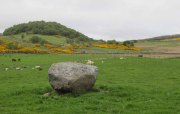The map could not be loaded. Please contact the site owner.
Souterrain (missing): OS Grid Reference – NC 5821 5471
Also Known as:
Archaeology & History
 The Royal Commission (1911) lads paid a visit to this site in June, 1909, after an earlier report—allegedly by James Horsburgh—told there to have been one close to the right-hand side of the road, but it has long since been forgotten. The Commission lads told us simply,
The Royal Commission (1911) lads paid a visit to this site in June, 1909, after an earlier report—allegedly by James Horsburgh—told there to have been one close to the right-hand side of the road, but it has long since been forgotten. The Commission lads told us simply,
“In a park about ¼-mile north of Ribigil farm-house is the site of an earth-house which was closed up many years ago.”
When I asked a number of local people about the place, they knew nothing of it; so I wandered around in the hope that I might find something. All that I came across, close to where it was described, were two large flat stones covering a hole in the ground on the other side of the fence from the road. A number of reeds were in the same field and I thought it must have been a well, but when I laid my ear to it, could hear no running water whatsoever.
References:
- Horsburgh, James, “Notes of Cromlechs, Duns, Hut-circles, Chambered Cairns and other Remains, in the County of Sutherland“, in Proceedings Society of Antiquaries, Scotland, volume 7, 1870.
© Paul Bennett, The Northern Antiquarian
